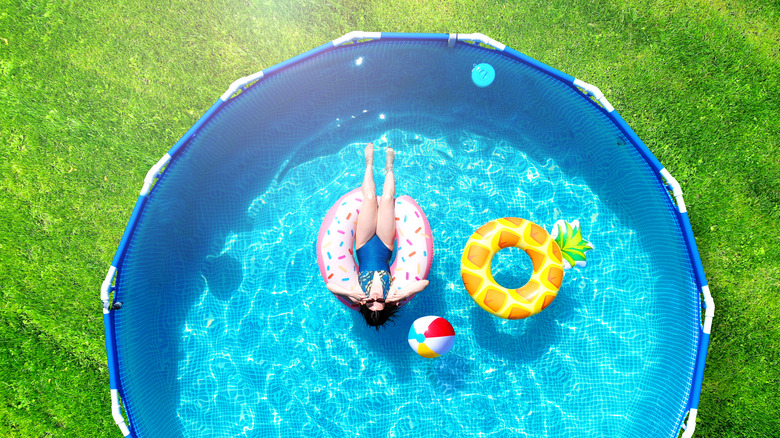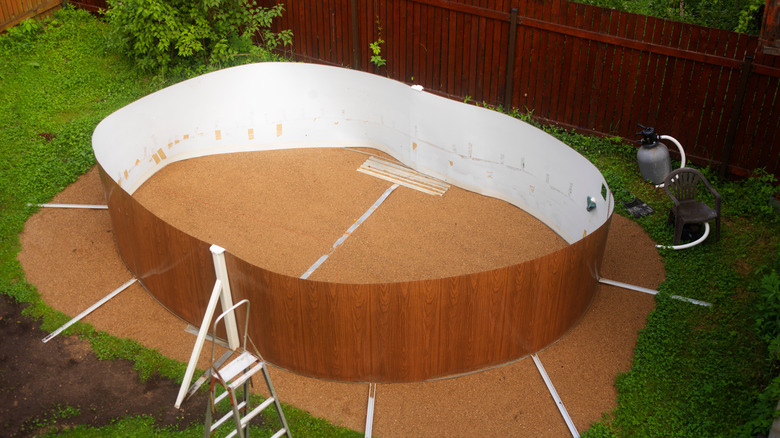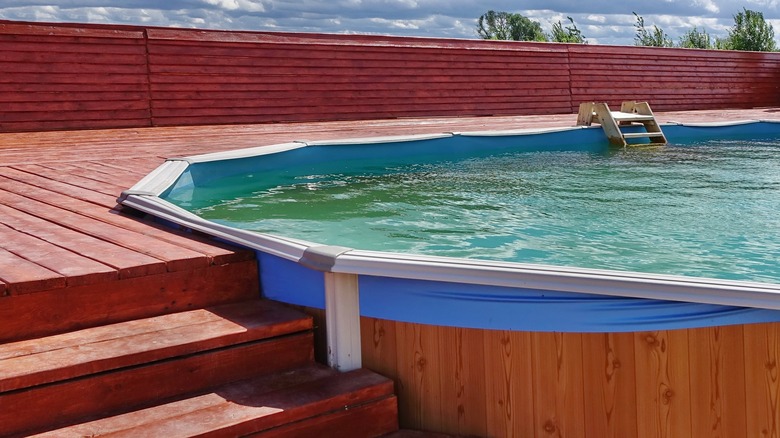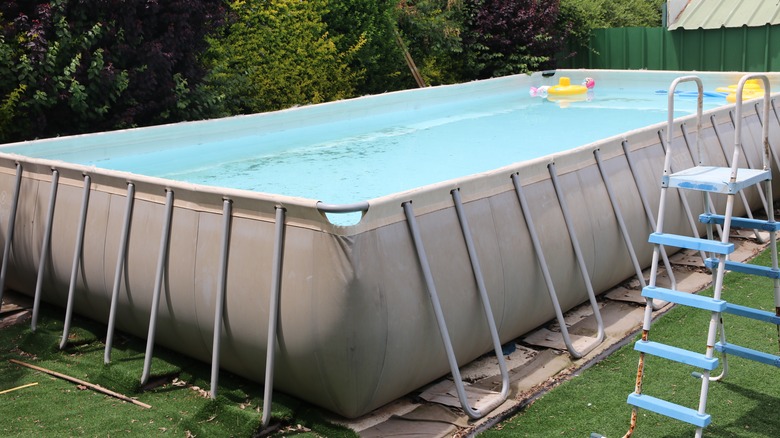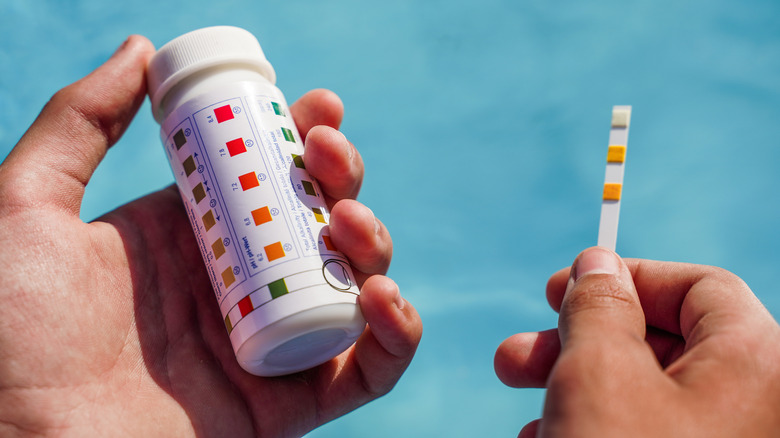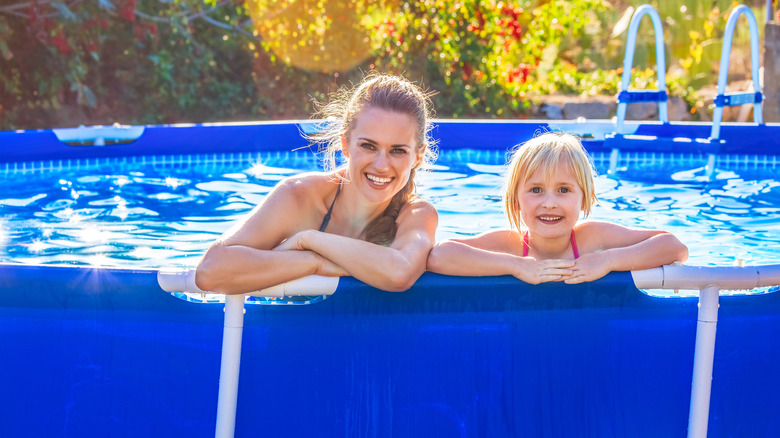How Much Does It Cost To Put In An Above Ground Pool?
As summer rolls around, you may looking for ways to get you and your family out and into the sunshine more often, and what better way to do that than installing your very own pool in your yard at home? Pools are a fun and healthy way to get outside, whether it's for a little physical activity or just to have fun with family and invited guests. Unfortunately, an average in-ground pool can cost between $28,000 and $55,000, and can take several weeks to install, according to Home Guide. There is, however, an alternative: an above ground pool.
Lawn Starter states that an average above ground pool that is professionally installed usually costs around $2,693. The Washington Post further explains that the most popular above ground pools are 24-foot-diameter round pools and 15- by 30-foot oval-shaped pools. Common depths range between 48 and 54 inches, with 52 inches being the most popular. If this fun, easy, and relatively cheap way to elevate your summer experience and get your family outside more often sounds right for you, keep reading. Below we've broken down all the costs of this backyard addition to help you find the best option to fit your wants, needs, and budget.
Factors for cost
It may sound simple enough to place this type of pool in your yard, but there are still some other factors that could affect the overall cost of your project. Let's take a look at some of those factors below.
Preparations
Although an above ground pool is not dug into the ground, hence the name, the land where you wish to place the pool still needs to be prepared accordingly. Per Bob Vila, the first step is to locate a safe area to place the pool. The pool should be situated away from any large or potentially dangerous obstacles, as well as septic lines, power lines, and cables. The ground must also be evenly leveled, firm, and free from shrubs, leaves, or any other types of garden debris. Depending on your skill level and the extent of preparations needed for your particular yard, you can either complete these tasks for free on your own or hire a paid professional of your choice.
Brand or materials
When it comes to purchasing an above ground pool, you can choose between the specific materials from which your pool will be made or a specific brand you wish to purchase. As for materials, most above ground pools are made from either steel, resin, or aluminum. Lawn Starter explains that each of these options has upsides and downsides. To put it simply, steel tends to be the cheapest and strongest option. Resin, on the other hand, is a bit more expensive but can provide a resistance to rust and oxidization. Aluminum is the most expensive material, however, it is also the lightest, making it the easiest to move. Aluminum also provides corrosion resistance along with the ability to with withstand harsh, cold climates.
When choosing a brand to invest in, Lawn Starter recommends Kayak, Doughboy, Intex, and Aqua Leader. Between brands, the quality and price of each pool can drastically vary. As a rule of thumb, expect the best quality pools to be listed with the highest prices.
Installation
Sometimes the help of a professional is not needed when installing an above ground pool. Lawn Starter states that, again, depending on your confidence and which above ground pool you decide to purchase, the project itself can be an easy do-it-yourself endeavor. If you feel more comfortable hiring a professional crew to install your pool, prepare to spend between $823 and $3,233.
Additional Costs
Along with the cost of the pool and the entire installation process, there are some additional elements regarding safety and comfort that may add to the total cost of your above ground pool. Let's take a look at some of these below.
Pool cover
When owning a pool, regardless of style or size, it becomes your responsibility to keep others safe around your new yard addition. Swimmingpool.com mentions that purchasing a pool cover is one of the safest ways to prevent accidents from occurring in your pool when it is not in use. As well as significantly preventing drowning accidents, pool covers keep insects and other debris out of your pool, allowing for a clean and comfortable swim.
Lawn Starter states that a pool cover can range widely in price. Most cost between $100 and $375, but larger and more luxurious options can stretch as far as $1,000.
Stairs or a ladder
Swimmingpool.com explains that most above ground pool kits already come with a ladder or stairs, but separately purchasing an upgraded version can make a huge difference in regards to safety and design. Not only will an upgraded set have better quality and last longer, it may also come with improved safety elements, for instance, curved stairs that slowly ease you into the pool or steps with a non-slip grip.
When it comes to cost, Lawn Starter estimates that pool ladders can cost around $166, depending on the quality and features attached to them. Pool steps, on the other hand, tend be a bit more expensive, usually averaging $211.
Calling an electrician
A pool pump, heater, and filter will all be part of your above ground pool's installation, all of which require electricity. Electricity must be installed properly and carefully to avoid the hazardous risk of mixing electricity and water. For the best and safest results, it is recommended to let a professional do this portion of the work. For a professional electrician, you can expect to pay between $52 and $95 per hour.
Additional yard features
When installing a new pool, you may also start to think about upgrading other portions of your yard, as well. Some of these additions could be a pool deck where you can relax and lounge comfortably, lights that can be strung across your yard or even in your pool for a unique nighttime swim, or extra water features, like a small waterfall or fountain. When it comes to pool decks, the full price will highly depend on the size you wish to build. According to Lawn Starter, you can expect a per square foot cost between $15 and $30. For lighting, the price should fall between $23 and $113 per fixture. Surprisingly, however, an average water feature can be added to your yard for as low as $28.
Types of above ground pools
When it comes to picking the perfect above ground pool for you and your family, Country Leisure claims that there are four main types to choose from. Each type comes with its own benefits, specific uses, and prices.
Inflatable above ground pool
An inflatable above ground pool is one of the simplest pools you can purchase. With this type of pool, you'll be able to make a splash within only a couple hours after making your purchase. Although you may expect an inflatable pool to be much smaller in size, it can actually be up to 18 feet in diameter and 52 inches deep. This makes them perfect for families with small children. Their manageable size also makes them very easy to remove from your yard without leaving a trace behind.
Inflatable pools tend to be inexpensive and can be set up without the help of a professional. They are, however, difficult to keep clean due to the inefficient equipment that is usually included. Sturdiness varies widely and the wall material tends to rip and tear rather easily.
Steel framed above ground pool
Unlike an inflatable pool, a steel-framed pool has much more to it. Although this option takes more time to install, the structure is sturdier with a steel frame that holds up the pool with railings, braces, and posts. Due to the increased strength of the walls, these pools can be purchased in much larger sizes that range up to 22 feet in diameter and 52 inches deep.
Despite the little extra elbow grease required to install a pool like this, it can be easily done without the help of a professional. Once installed, they can be moved quite easily, as well. You may want to upgrade your steel frame pool with nicer equipment like ladders, pumps, and filters. Keep in mind that it will all need to be packed away during the harsh winter months.
Traditional above ground pool
If you want your pool to be a more permanent feature in your yard, a traditional above ground pool is the type for you. Typically, traditional above ground pools are made from metal, resin, or a combination of both of these materials. They are very sturdy and come in sizes as large as 36 feet in diameter and 54 inches deep.
Traditional above ground pools tend to be very durable, lasting a good 15 to 20 years when maintained properly and are pretty easy to keep clean. The downside to this type of above ground pool, however, is the land preparation and installation process, which may require professional help. It's a permanent pool, but still with less functionality than an in-ground pool. For example, it will lack a deep end that could feature a diving board and slide.
Semi-in-ground pool
A semi-in-ground pool is a rather new type of above ground pool that is only partially buried into the ground. Similar to traditional in-ground pools, semi-in-ground pools require the help of professionals for the installation process, which can be rather expensive and take several weeks to complete. Despite this, these pools can be a luxurious addition to your yard, bringing the perfect summer escape right to your home with defined deep and shallow ends, nearly unbreakable walls, and plenty of opportunities for extras, like a diving board or a slide.
Maintaining your above ground pool
Before investing in a brand new pool, you may want to know the amount of maintenance it requires to keep it both safe and enjoyable to use for years to come. Family Handyman shares that above ground pools tend to be much easier to maintain than in-ground pools, but still lists a variety of maintenance tips you should follow to sustain your pool's crisp look and help it last longer.
Maintain chlorine levels
Pools are known for collecting a variety of algae, bacteria, and other harmful organisms when left unattended. Using chlorine, however, is one of the most common and easiest ways to prevent these organisms from infesting your pool water. While applying chlorine to your pool sounds simple enough, it must be kept at a sustained level to remain effective. Because chlorine breaks down quickly when exposed to sun, sweat, and other foreign chemicals, chlorine tests must be done daily to ensure your pool still has enough chlorine to continue fighting off the unwanted and harmful organisms.
Shock treatments
If an issue arises or you are unable to test and adjust your chlorine levels when needed, you can use a shock treatment to revive your pool's cleanliness in a rather quick and easy manner. Home Depot states that a shock treatment is when you add large amounts of chlorine or non-chlorine chemicals to your pool until the "free chlorine" level raises to the point where unwanted organisms will die.
Running pool pump
Along with the use of chemicals, Family Handyman also recommends running your pool pump for a minimum of eight hours each day. Circulating your pool water can further prevent the growth of algae, as well as keep water clean and clear by sweeping debris into your pool filter. Although eight hours are recommended, your pool's manual can give you a more exact and effective time to run your pump.
Cleaning and replacing filter
As debris is swept into your pool's filter, it can pile up and make the filter less and less effective. This is why you must pay special attention to your pool filter and change it as needed. As a rule of thumb, you should clean your pool filter at least once a week, which simply consists of removing the cartridge and quickly hosing it down before placing it back in its position. Replacing the filter entirely will only occasionally be necessary, as dictated in your pool's manual.
Cleaning pump and simmer baskets
Along with cleaning out your pool filter, your pump and skimmer baskets should also be cleaned out every once in a while. Family Handyman explains that a pump basket catches debris before it reaches your pool pump, while a skimmer basket simply catches debris that floats on the surface of the water.
Similar to the filter, these baskets should be cleaned out at least once a week, or more frequently if your pool is located in an area where it catches a lot of debris from nearby trees or other vegetation. It's important to note, however, that these baskets are best cleaned when the pool pump and heater are switched off to avoid the rotation of debris out of these baskets and back into the pool.
Using pool vacuum
Although filters work on a continual basis, they may not be 100% effective. This is why Family Handyman also recommends using a pool vacuum at least once a week to thoroughly clean out your pool. Regular vacuuming will not only further prevent the growth of algae, but it can also assist the functionality of chlorine by clearing the pool of materials that break it down.
Bob Vila highly recommends the Dolphin Nautilus CC Robotic Pool Vacuum for your pool vacuuming needs, but the U.S. Pool Supply Weighted Pool Vacuum Head also comes highly recommended for those who are looking for equipment that is more budget-friendly.
Properly winterize
As mentioned before, some above ground pools are meant to be disassembled and packed away for the harsh winter months, when they will not be in use. Traditional above ground pools, however, are designed to permanently remain in your yard. If this is the case, your pool must be properly prepared for winter.
Per Family Handyman, professionals do not recommend draining your pool for winter. Instead, they say to first ensure your pool is properly cleaned and balanced with the right amount of chemicals. After that, the pool lines should be removed, and safely packed away with the pool pump, filter, and other main pool accessories. Lastly, cover your pool with either a pool air pillow or any sort of pool cover to protect it as it waits for next summer to roll around.
Benefits of having an above ground pool
When it comes to installing a pool in your yard, most people automatically jump to an in-ground pool without considering their other options. Despite the negative appeal that can follow an above ground pool, they bring a variety of benefits to your home that might just be better for you and your family.
Affordable price
To put prices into perspective, Home Guide mentions that an average in-ground pool usually costs between $28,000 and $50,000, making this type of addition a major investment. Above ground pools, on the other hand, only cost an average of $2,693, according to Lawn Starter. By choosing an above ground pool, you can save over $20,000 and still get a great quality pool.
Quick installation
Along with its rather cheap price, above ground pools are also relatively quick and easy to install. In addition to spending thousands upon thousands of dollars for an in-ground pool, you would also have to wait weeks or sometimes even months for your pool to be professionally installed. Above ground pool installation can take less than a day and can usually be done without the help of a professional.
Safe to use
Crystal Pools Inc. explains that an above ground pool can also be a much safer addition to your yard, compared to in-ground pools. Because above ground pools have a higher entry point, usually ranging around 52 inches high, they are less likely to cause accidents, like a child accidentally falling into the pool. Above ground pools can also be easily purchased in a variety of smaller sizes to best fit children, posing even less of a risk of drowning.
Easy to maintain
Finally, above ground pools are also very easy to maintain compared to in-ground pools due to relatively smaller sizes and unique constructions. They do not take as long to clean, can be easily cleaned without help from a professional or other outside source, and require fewer chemicals to stay well maintained.
